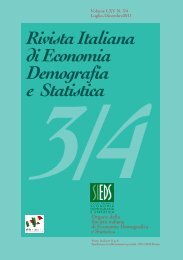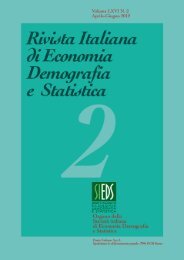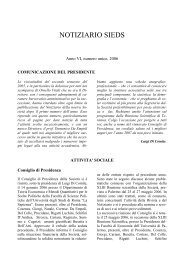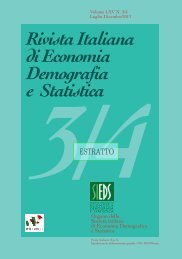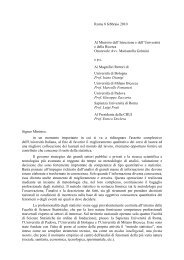rivista italiana di economia demografia e statistica - Sieds
rivista italiana di economia demografia e statistica - Sieds
rivista italiana di economia demografia e statistica - Sieds
Create successful ePaper yourself
Turn your PDF publications into a flip-book with our unique Google optimized e-Paper software.
Rivista Italiana <strong>di</strong> Economia Demografia e Statistica Volume LXIII nn. 3-4 – Luglio-Dicembre 2009<br />
SOCIAL EXCLUSION IN EUROPEAN REGIONS:<br />
A MULTILEVEL LATENT CLASS MODEL<br />
Elena Pirani<br />
1. Modelling social exclusion<br />
In recent years the term social exclusion has taken a prominent place in<br />
<strong>di</strong>scussions concerning social policies and inequalities, in all European countries.<br />
Social exclusion is not only a negative con<strong>di</strong>tion per se, it also represents a<br />
<strong>di</strong>sruptive element for social and economic development, entailing the risk for<br />
people to become excluded from the mainstream society. The fight against poverty<br />
and social exclusion is one of the central objectives of the European Union, in a<br />
context where the links between the economic and the social spheres are assuming<br />
an increasing central importance. We propose a <strong>statistica</strong>l framework to study<br />
social exclusion considering at the same time both relational and <strong>di</strong>stributional<br />
aspects. The proposed hierarchical latent class model allows accounting for all<br />
these elements, also in a subjective perspective, and considering the <strong>di</strong>fferent<br />
contexts in which in<strong>di</strong>viduals live and that may affect their perceptions.<br />
In the literature, there is agreement in considering social exclusion a<br />
multi<strong>di</strong>mensional concept (e.g. Room 1995, Atkinson and Davou<strong>di</strong> 2000, Peace<br />
2001). Multi<strong>di</strong>mensionality implies that deprivation and lack of resources<br />
determining social exclusion have to refer to a broad set of quantitative and<br />
qualitative factors. The relevance of the <strong>di</strong>fferent elements of exclusion may be<br />
<strong>di</strong>fferent depen<strong>di</strong>ng on the context, in term of time and place (Mayes et al. 2001,<br />
Bhalla and Lapeyre 2004). Referring to the fifteen countries belonging to European<br />
Union in 2001, we propose a conceptual model of social exclusion based on the<br />
identification of three principal <strong>di</strong>mensions representing the spheres of human life<br />
in which it is most important for in<strong>di</strong>viduals to participate: the economic, the social<br />
and the institutional <strong>di</strong>mensions. These three <strong>di</strong>mensions refer to <strong>di</strong>fferent areas of<br />
human life that interact and influence reciprocally, and exclusion in one <strong>di</strong>mension<br />
could determine or make worse exclusion in the others (Bhalla and Lapeyre 2004).<br />
The economic <strong>di</strong>mension refers to monetary and financial aspects and, in a<br />
broader sense, it includes the subject’s capability to access goods and services<br />
market and the subject actual living con<strong>di</strong>tions. The social <strong>di</strong>mension concerns<br />
with the domain of relations among in<strong>di</strong>viduals. The relationship networks with<br />
family, friends, neighbours, local community, and so on, may be viewed as forms<br />
of social capital at in<strong>di</strong>vidual level, that can be activated when necessary, thus



